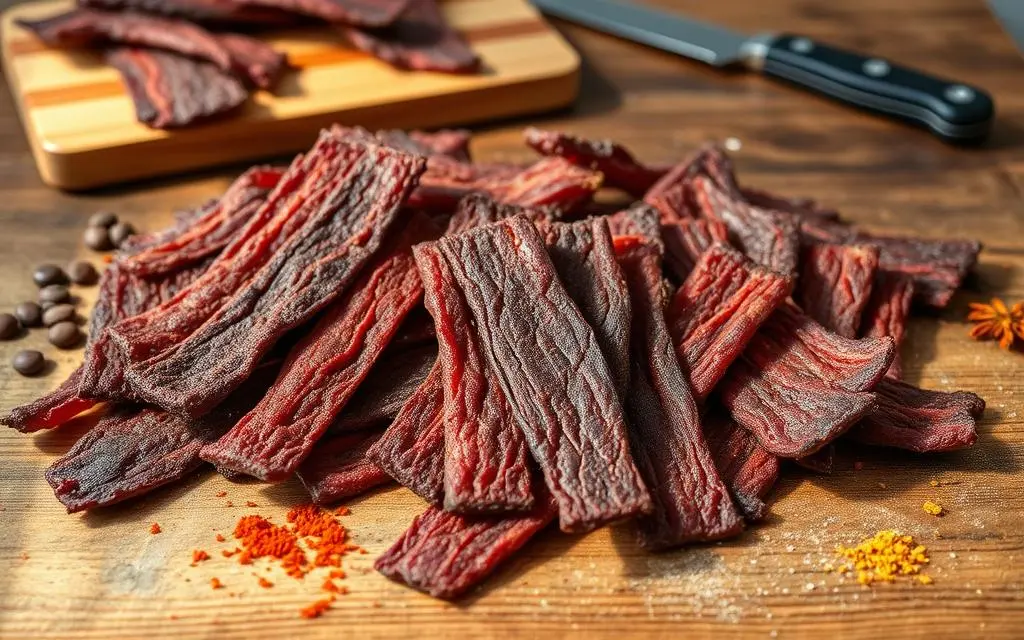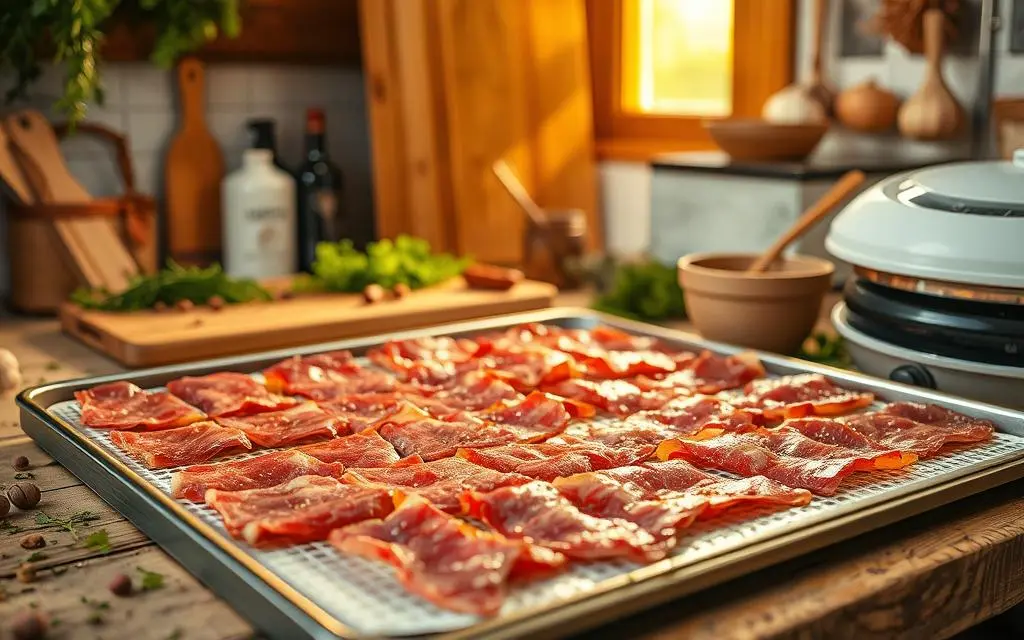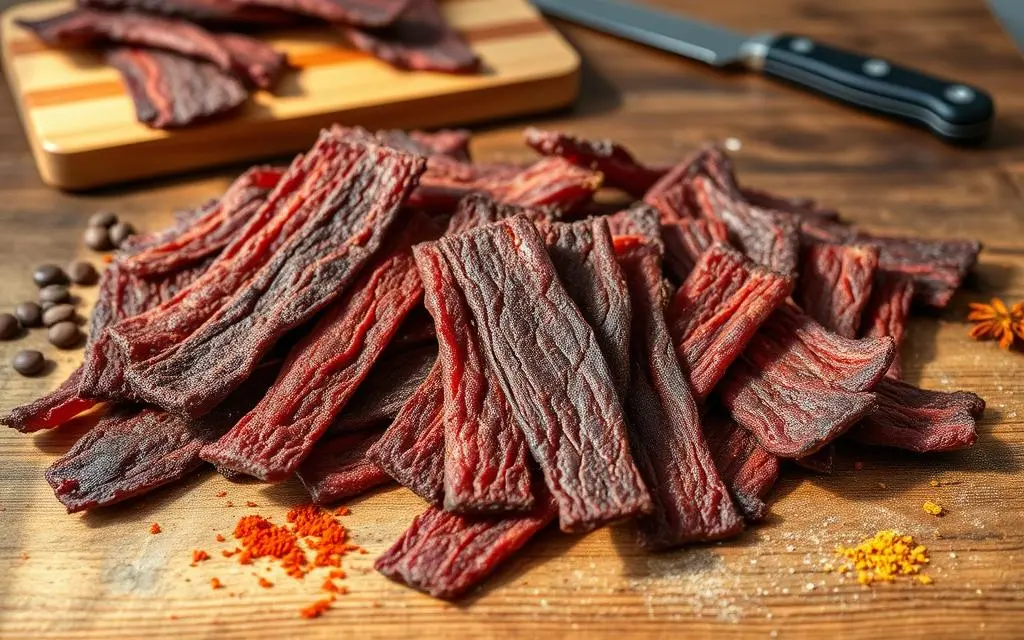The Best Homemade Beef Jerky Recipe 2024
Ready to take your snacking to the next level? Discover how to make the best homemade beef jerky. It’s a journey of flavor and fun. We’ll show you how to dehydrate meat and the perks of making jerky at home.
Get ready for a recipe that’s packed with protein and smoky taste. It’s so good, you’ll want more and more.

Key Takeaways
- Learn the essential techniques for making the perfect homemade beef jerky
- Discover the benefits of creating your own jerky, from cost-saving to flavor customization
- Explore the art of selecting the right cut of beef for your jerky
- Master the marinade and seasoning process to achieve your desired flavor profile
- Understand the differences between oven drying and using a dehydrator for the best results
Introduction to Homemade Beef Jerky
Homemade beef jerky is a tasty, protein-rich snack. It’s full of flavor and easy to carry around. It’s perfect for outdoor lovers, health buffs, or anyone who enjoys making food.
The Art of Dehydrating Meat
Dehydrating meat turns it into beef jerky. It removes moisture, leaving behind lots of protein and flavor. This method makes the meat tender and chewy.
It also lets you try different seasonings and marinades. This way, you can discover many unique flavors.
Benefits of Making Jerky at Home
Making your own beef jerky has many perks. You can skip the preservatives and additives found in store-bought jerky. Plus, it’s often cheaper, saving you money.
You can also make it your own by trying out different spices and marinades. This lets you create special, unique flavors.
| Benefit | Description |
|---|---|
| Ingredient Control | Avoid preservatives, additives, and hidden sugars found in store-bought jerky |
| Cost Savings | Homemade jerky can be more cost-effective than commercial options |
| Customization | Experiment with your own spice blends and marinades to create unique flavors |

“Dehydrating meat is a time-honored technique that allows you to preserve the natural flavors and nutrients of the meat, transforming it into a delicious, shelf-stable snack.”
Selecting the Right Cut of Beef
Choosing the right beef cut is key to making great homemade beef jerky. The texture, flavor, and quality of your protein snack depend on it. Knowing the differences in beef cuts helps you pick the best one for your beef preservation project.
Lean and tender cuts like flank steak or sirloin are top picks for beef jerky. They have the right mix of fat and connective tissue. This ensures a good chew and flavor. Top round or bottom round roasts also make great jerky, with a lean and meaty texture.
When picking your beef, think about these things:
- Marbling: A bit of intramuscular fat, or marbling, adds flavor and moisture to your jerky.
- Leanness: Choose lean cuts with little external fat to avoid too much shrinkage when drying.
- Texture: Look for tender but firm cuts for a jerky that’s easy to chew.
| Beef Cut | Characteristics | Suitability for Jerky |
|---|---|---|
| Flank Steak | Lean, fibrous texture with moderate marbling | Excellent |
| Sirloin | Tender, with a balance of fat and lean muscle | Excellent |
| Top Round | Lean, with a firm, dense texture | Good |
| Bottom Round | Lean, with a firm, dense texture | Good |
By choosing the right beef cut, you can make your homemade beef jerky a real treat. It will have the perfect mix of texture, flavor, and protein snack enjoyment.

Jerky Recipe: Marinade and Seasonings
Making the perfect jerky marinade is key to tasty marinated jerky. You can choose from classic flavors to bold spice blends. This lets you add amazing smoky flavors to your homemade jerky.
Classic Jerky Marinade
The classic jerky marinade is easy yet effective. It uses soy sauce, Worcestershire sauce, and brown sugar as a base. Add garlic, onion, and a bit of liquid smoke for a full flavor.
- Soy sauce
- Worcestershire sauce
- Brown sugar
- Garlic, minced
- Onion, diced
- Liquid smoke (optional)
Exploring Spice Blends and Flavors
While the classic jerky marinade is loved by many, feel free to try new spice blends. Add chili powder, cayenne, or crushed red pepper flakes for a spicy kick. Smoked paprika or chipotle powder can give a smoky flavor. Herbs like rosemary, thyme, or oregano add depth to your marinated jerky.
The best thing about homemade jerky is you can make it your own. Use the classic marinade as a starting point. Then, add your favorite seasonings and spices to make it unique.
Dehydration Techniques for Beef Jerky
Making tasty homemade dehydrator recipes and mastering oven drying are key to great dehydration techniques for beef jerky. You can use a dehydrator or your oven, each with its own benefits. They help you get the right texture and flavor for your jerky.
Oven Drying vs. Dehydrator
If you don’t have a dehydrator, your oven can still work well for oven drying beef jerky. You can control the temperature and air flow for even drying. But, keep an eye on the meat to prevent it from getting too dry or overcooked.
A dehydrator recipes gives you a more efficient and even drying. These machines spread hot air all around the meat for uniform drying. This makes your jerky tender and flavorful, and it’s easy to use.
| Feature | Oven Drying | Dehydrator |
|---|---|---|
| Temperature Control | Requires manual adjustment | Precise temperature settings |
| Airflow | Depends on oven design | Designed for even air circulation |
| Convenience | Requires more hands-on monitoring | Set-and-forget operation |
| Texture | May result in slightly tougher jerky | Produces a more tender texture |
Choosing between oven drying and a dehydrator recipes depends on what you like and what you have. Knowing the differences between these dehydration techniques helps you make the best choice. This way, you can make homemade beef jerky that tastes and feels just right.
Jerky Recipe
Making the perfect beef jerky at home is a fun challenge. It requires patience and careful attention. This jerky recipe will help you make tasty, protein-rich snacks. Your friends and family will love them.
Start by picking a good cut of beef, like flank steak or top round. Cut it into thin strips, about 1/4 inch thick. Make sure to cut against the grain for tender jerky.
- Make the marinade by mixing soy sauce, Worcestershire sauce, brown sugar, garlic powder, onion powder, and black pepper in a big bag or container. Add the beef strips and mix well. Refrigerate for at least 4 hours, or up to 24 hours, to soak up the flavors.
- Set your oven to its lowest temperature, usually around 135°F (57°C), or use a dehydrator at 155°F (68°C). Place the marinated beef on a baking sheet or dehydrator tray, making sure they don’t touch.
- Dehydrate the beef jerky for 4-8 hours, depending on your oven or dehydrator. It should be dry and leathery but still flexible. Check and rotate the trays or sheets to dry evenly.
When your homemade jerky is done, let it cool completely. Store it in an airtight container. It can last up to 2 weeks at room temperature, making it a great snack anytime.
The secret to the best jerky recipe is using quality ingredients and following the steps carefully. With practice, you’ll make beef jerky that’s as good as store-bought.
Storage and Food Safety
Keeping your homemade beef jerky fresh and safe is key. Knowing how to store and package it right helps. This way, your tasty dried meat snacks stay good for a long time.
Proper Packaging and Shelf Life
Right packaging is vital for jerky’s shelf life. Use airtight containers or resealable bags, removing air. This stops moisture, oxidation, and contamination from spoiling your jerky.
At room temperature, most jerky lasts 1-2 weeks. Freezing it can extend this to 6 months. Always mark your packages with the making date to know when they were made.
| Storage Conditions | Shelf Life |
|---|---|
| Room temperature (70°F or below) | 1-2 weeks |
| Refrigerator (40°F or below) | 2-3 weeks |
| Freezer (0°F or below) | 6-12 months |
Good jerky storage and food preservation are crucial. They keep your homemade dried meat snacks fresh and tasty for a long time. Follow these tips to enjoy your beef jerky for as long as you can.
Conclusion
Making beef jerky at home is a fun and tasty project. You can pick the best meat, create a great marinade, and dry it perfectly. This way, you get a snack that’s full of flavor and protein, better than what you can buy.
With homemade jerky, you control what goes into it and can make it taste just how you like. You can stick to traditional flavors or try something new and exciting. This makes beef jerky a great way to enjoy healthy snacks.
Start by getting your ingredients ready and setting up your dehydrator or oven. Then, dive into making your own beef jerky. It’s a journey that’s as enjoyable as the end result. You’ll get to enjoy tasty, protein-rich snacks that are all your own.
FAQ
What is the best cut of beef for making homemade jerky?
For homemade jerky, choose lean, tender cuts. Flank steak, top round, bottom round, or eye of round are great. They offer the perfect mix of fat and muscle for a tasty, chewy texture.
What is the classic jerky marinade recipe?
The classic marinade includes soy sauce, Worcestershire sauce, brown sugar, garlic, and black pepper. This blend tenderizes the meat and adds a rich, savory flavor.
What are the benefits of making jerky at home?
Making jerky at home saves money and lets you control what goes into it. You can also try new flavors without preservatives found in store-bought jerky.
What’s the difference between oven drying and using a dehydrator for making jerky?
Both oven drying and dehydrators dry meat for jerky. But, dehydrators offer better temperature control and airflow. This makes the jerky drier and chewier. Oven drying might need more attention and can result in a slightly different texture.
How long does homemade beef jerky last, and how should it be stored?
Homemade beef jerky lasts up to 2 weeks at room temperature or 6 months in the freezer. Store it in an airtight container or ziplock bag to keep it fresh. Refrigeration can also help it last longer.

